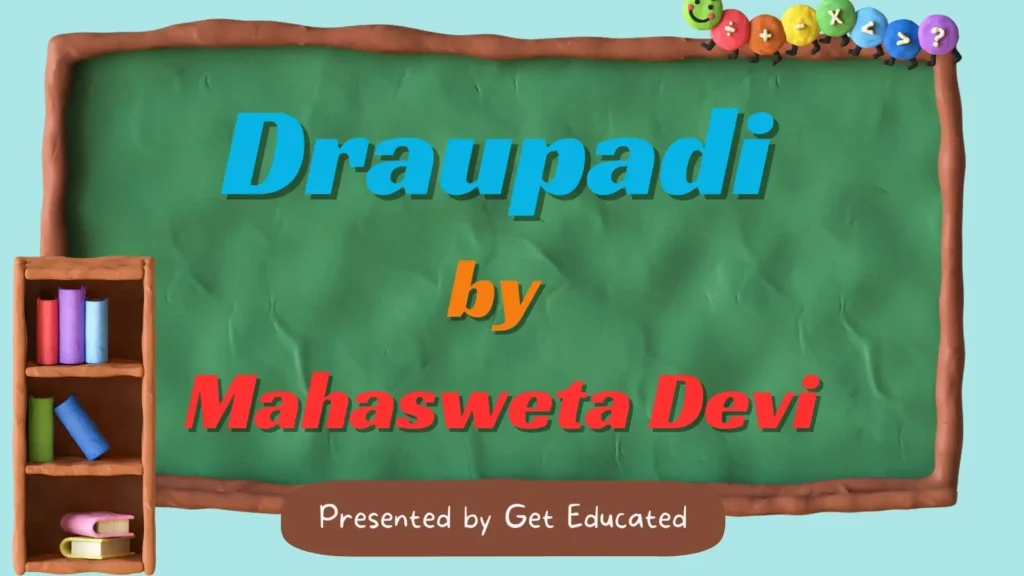
Draupadi is a story about Dopdi Mehjen, a woman who belongs to the Santhal tribe of West Bengal. She is a Robin Hood-like figure who with her husband, Dhulna, murders wealthy landlords and usurp their wells, which is the primary source of water for the village. The government attempts to subjugate these tribal rebel groups through many means: kidnapping, murder, rape. Dopdi is captured by Officer Senanayak who instructs the army officers to rape her to extract information about the rebel uprising.
On the run, Dopdi is captured by government forces. Hoping that torture would force the captive to reveal other insurgents in the network, Mr Senanayak’s (the officer in charge) men gangrape Dopdi through the night, at his bidding. In the morning, when she is summoned to the Burra sahib’s tent, her rapists order she clothes herself when she refuses to.
The story ends with the powerful image and words of Dopdi, who tears up her clothes and walks naked toward Senanayak’s tent. “Senanayak walks out surprised and sees ‘Draupadi’, naked, walking towards him in the bright sunlight with her head high.” “There isn’t a man here that I should be ashamed of. I will not let you put my cloth on me. What more can you do?” Dopdi asks in defiance.
The conclusion of the story brings to mind another evocative image—of 12 mothers from across Manipur, known as imas, in Meitei, taking off their clothes in protest outside the Assam Rifles headquarters in 2004. Their radical action expressed the mothers’ collective outrage over the brutal killing of 32-year-old Manorama Thangjam by the Assam Rifles 17 years ago.
Dopdi’s subjectivity is suggested throughout the story, but it is her act of resistance at the end that sees her truly embodying her subjecthood. Senanayak orders his men to rape her, and then to bring her before him, clothed. She throws aside the cloth, refusing to put it on, and asserts herself before all of the men: “Draupadi’s black body comes even closer. Draupadi shakes with an indomitable laughter that Senanayak simply cannot understand. Her ravaged lips bleed as she begins laughing. Draupadi wipes the blood on her palm and says in a voice that is as terrifying, sky splitting, and sharp as her ululation, What’s the use of clothes? You can strip me, but how can you clothe me again? Are you a man? She looks around and chooses the front of Senanayak’s white bush shirt to spit a bloody gob at and says, There isn’t a man here that I should be ashamed. I will not let you put my cloth on me. What more can you do? Come on, counter me-come on, counter me-? Draupadi pushes Senanayak with her two mangled breasts, and for the first time Senanayak is afraid to stand before an unarmed target, terribly afraid.” Akshaya Ramesh explains that “Draupadi looks like a victim but acts like an agent. Indeed, the binary of victim and agent falls apart as Draupadi effectively separates violation from victimhood. As she stands insistently naked before her violators, Dopdi manages to wield her wounded body as a weapon to terrify them.”
Dopdi, the protagonist, embodies the spirit of resistance. She is a tribal woman who, alongside her husband, Dulna, fights for the basic right to water for her community. This struggle pits them against the powerful Senanayak, who controls the only source of water in the drought-stricken region. Dulna is brutally killed by Senanayak’s men, leaving Dopdi alone and vulnerable.
However, Dopdi does not succumb to despair. Instead, she chooses defiance. In the story’s final scene, she walks naked towards Senanayak’s tent, tearing her clothes to shreds. This act is not one of submission, but of powerful self-assertion. She strips herself bare, physically and metaphorically, challenging the power dynamics that have subjugated her and her community.
The symbolism of Dopdi’s nakedness is multifaceted. It represents vulnerability, stripping away the layers of societal expectations and norms. It also signifies defiance of patriarchal oppression, refusing to be objectified or shamed. Furthermore, it can be seen as a reclaiming of agency, owning her own body and using it as a weapon against the forces that seek to control her.
Dopdi’s nakedness also evokes the image of Draupadi, the mythological character from the Mahabharata who was disrobed in a public assembly. Unlike Draupadi, who was saved by divine intervention, Dopdi chooses her own path. She does not wait for a male savior but faces her oppressor directly, her gaze unwavering.
In the end, Dopti dares the main perpetrator, Senanayak, to look her in the eye, to confront her bruised, exposed body: “And for the first time Senanayak is afraid to stand before an unarmed target, terribly afraid.” A chilling fear strikes the powerful on realising their powerlessness, on realising their abuse and violence have produced the very opposite of what they intended. Torture renders its victims fearless.
This ending is deliberately ambiguous. It offers no easy resolutions, no clear-cut victories. Instead, it leaves the reader questioning the nature of power, resistance, and the complexities of confronting injustice. Does Dopdi’s act of defiance offer hope for change or is it a tragic act of futility? The story does not provide answers, but rather invites the reader to engage in dialogue and critical reflection.
Mahasweta Devi’s ‘Draupadi’ is a powerful testament to the human spirit’s capacity for resilience. Through Dopdi’s unflinching gaze and unwavering courage, the story reminds us that even in the face of overwhelming odds, the flame of resistance can never be truly extinguished.
